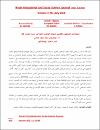استخدام الصحفيين القطريين لشبكات التواصل الاجتماعي- دراسة لحصار دولة قطر
| Author | الشامي, عبد الرحمن محمد سعيد |
| Available date | 2018-09-11T11:06:27Z |
| Publication Date | 2018-12-02 |
| Publication Name | Route Education and Social Science Journal |
| Identifier | http://dx.doi.org/10.17121/ressjournal.1423 |
| Citation | Shami, Abdulrahman. Qatari journalists uses of social media networks Applied study on the Qatar blockade. Route Education and Social Science Journal 2018 . Volume 5 . Issue 9 . p.p. 920- 941 |
| ISSN | 2148-5518 |
| Abstract | سعت هذه الدراسة إلى تقصي كيفية توظيف الصحفيين القطريين لشبكات التواصل الاجتماعي، في إطار جهودهم الإعلامية لمواجهة الحصار المفروض على بلادهم منذ 5 يونيو 2017، والأدوار المتبادلة بين وسائل الإعلام التقليدية من ناحية؛ وشبكات التواصل الاجتماعي من ناحية أخرى. وهدفت الدراسة إلى رصد أبرز استخدامات الصحفيين القطريين لهذه الشبكات، والكشف عن أهم الموضوعات التي تم تداولها، والأهدافؼ التي سعى هؤلاء الصحفيون إلى تحقيقها، ومدى التكامل بين الإعلام الجديد، والإعلام القديم، والإضافة التي تمثلها شبكات التواصل الاجتماعي للعمل الصحفي. وتنتمي هذه الدراسة إلى البحوث الوصفية التي تحاول توظيف منهج تحليل المضمون بشقيه : الكيفي والكمي، وقد تم تطبيقها على حسابات عينة من حسابات الصحفيين القطرين على شبكة التواصل الاجتماعي "توتير" خلال شهر أكتوبر من العام 2017. ومن أهم ما انتهت إليه الدراسة، أن شبكات التواصل الاجتماعي تعتبر وسيلة اتصالية تفي بأغراض الاتصال المختلفة، فهي منصات للترويج الشخصي، وغير الشخصي، كما تتنوع الرسائل التي تبث عبر هذه المنصات، ما بين التغريدات، والوسوم hashtags ، والفيديو، والصور، والرسوم المعلوماتية، والصور والرموز الرقمية emoji ، فضلا عن جوانب التفاعلية العديدة التي تتيحها هذه الشبكات. كما أوضحت الدراسة استعمال الصحفيين القطريين لهذه الشبكات لأغراض عدة، منها: كشف الأخبار الزائفة، وإبراز تناقضات خطاب دول الحصار، ومواجهة الخطاب التحريضي. أما من حيث الشكل، فقد برز استعمال لغة الإعلام في معظم الأوقات، مع وجود بعض مفردات اللهجات الخليجية أحيانا. وتوصي الدراسة بضرورة التزام الصحفيين بالأخلاقيات المهنية، حتى في حال النشاط على شبكات التواصل، والنأي بالشعوب عن الخلافات السياسية بين الدول، بالإضافة إلى إعادة النظر في نشاط الصحفيين على شبكات التواصل، أو على الأقل وضع ضوابط لهذا النوع من النشاط الصحفي، بحيث يكوف أكثر مهنية. |
| Language | ar |
| Publisher | Rota Career |
| Subject | حصار قطر - الأزمة - الوطن العربي حصار قطر - العلاقات الدولية شبكات التواصل الاجتماعي - الأزمة الخليجية - حصار قطر منتدى دراسات الخليج - حصار قطر Social media networks - Qatar Blockade Social media - Qatar Blockade Qatari journalists - Gulf crisis - Qatar Blockade |
| Alternative Title | Qatari journalists uses of social media networks Applied study on the Qatar blockade |
| Type | Article |
| Pagination | 920 - 941 |
| Issue Number | 9 |
| Volume Number | 5 |
| Alternative Abstract | This study investigates how Qatari journalists use social media networks (SMN) as part of efforts to represent the blockade imposed on their country since June 5, 2017. It looks into the interrelation between traditional media and SMN. It aims to document the ways Qatari journalists use SMN, the most important subjects they discuss, and the goals they seek. The study also dwells on aspects of convergence between new and traditional media, and the value SMS interactivity adds to Qatari journalism. The research is descriptive and triangulated in terms of method as it merges qualitative and quantitative analyses to arrive at findings. The study finds that SMN are media that meet different communicative purposes. They are platforms for promoting personal and non-personal affairs. Messages disseminated across these platforms range from tweets, hashtags, videos, photos, infographics, and emojis, as well as a variety of types of interactivity. The study shows that Qatari journalists use SMN for several purposes. These include, among other things, the uncovering of fake news, highlighting the contradictions in the discourse of the blockading countries and focusing on how to confront it. Tweets lean on simplified language, with traces of dialects current in the oil-rich Arab Gulf states. The study recommends that journalists should abide by professional ethics, even when resorting to SMN. Professional reporters should distance themselves from openly siding with parties in the conflict even on SMN pages. The study concludes that there is an urgent need for SMN regulation in Qatar and Gulf counterparts.communicative purposes. They are platforms for promoting personal and non-personal affairs. Messages disseminated across these platforms range from tweets, hashtags, videos, photos, infographics, and emojis, as well as a variety of types of interactivity. The study shows that Qatari journalists use SMN for several purposes. These include, among other things, the uncovering of fake news, highlighting the contradictions in the discourse of the blockading countries and focusing on how to confront it. Tweets lean on simplified language, with traces of dialects current in the oil-rich Arab Gulf states. The study recommends that journalists should abide by professional ethics, even when resorting to SMN. Professional reporters should distance themselves from openly siding with parties in the conflict even on SMN pages. The study concludes that there is an urgent need for SMN regulation in Qatar and Gulf counterparts. |
Files in this item
This item appears in the following Collection(s)
-
Mass Communication [75 items ]
-
Research Papers [21 items ]


